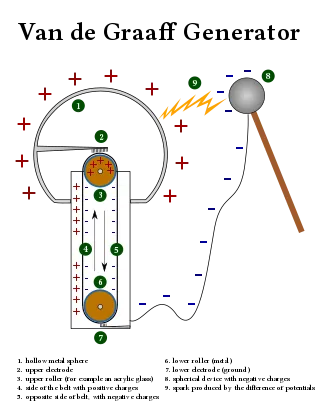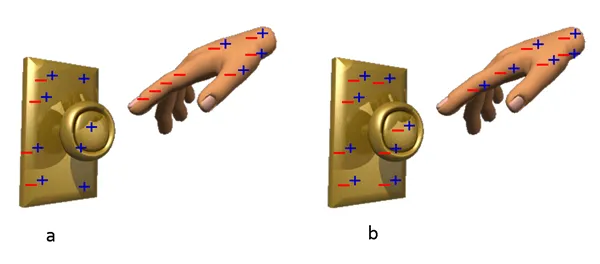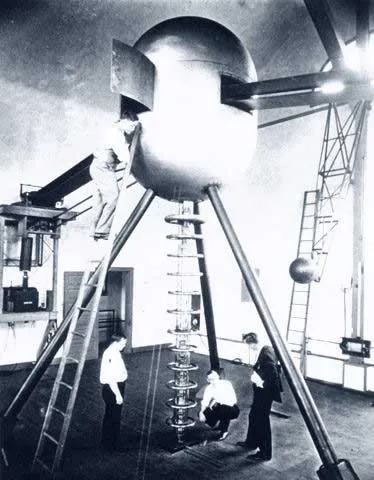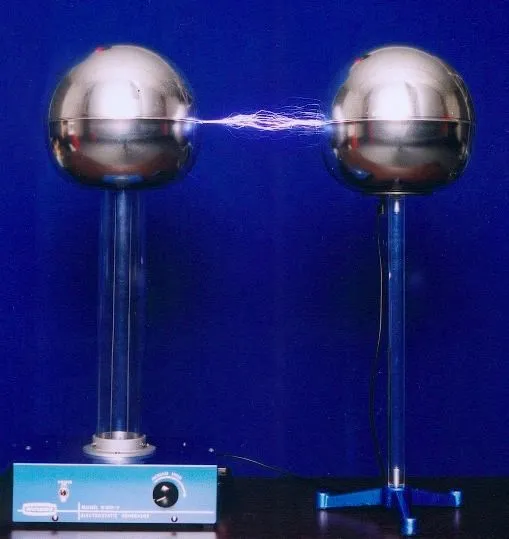Perhaps in a high school science class you saw a large metal ball, fixed on a small tower that could produce lightning bolts, make your hair stand on end, and supply painful shocks. These devices are known as Van de Graaff generators, and serve as one of the simplest high voltage power supplies in existence. VdG generators can produce some of the highest voltages ever obtained, and served to drive things like some of the earliest particle accelerators.
Invented by Robert J. Van de Graaff in the late 1920s, Van de Graaff generators are still used today for science demonstrations, research, and as novelty toys. Miniature ones can be made using a motor, a rubber band, and a soda can. The biggest ones can reach up to 5 million volts in air, and several times more when insulated.

Van de Graaff Generator Diagram
Credit
As usual, the inner workings of the VdG generator rely on some physical concepts that need to be covered first. Let's start with the Triboelectric Effect.
The Triboelectric Effect
Ever shocked yourself on a door knob or car door? Essentially everyone who doesn't live in a place as humid as the Amazon has experienced this. The reason this happens is because electric charge has built up on your body, and when your hand gets near the neutral metal door knob, the electric field ionizes the surrounding air, creating a plasma arc that rips the charges out of you and transfers them to the door, creating a brief pulse of electric current through your body that you feel as a shock. But where does this charge come from?

After you are charged from walking on the carpet, moving your hand near a metal object polarizes the object.
Credit
The Triboelectric Effect describes this phenomenon. When some materials are rubbed together, charge is transferred from one material to the other. Some examples of this include unrolling sticky tape, walking on the carpet in socks, or rubbing a glass rod with a silk cloth. Different materials produce difference charge buildups and at different rates. The static electric shocks you receive from walking on the carpet are actual driven by thousands of volts - the current is simply too low to harm you due to the low quantity of charge being transferred. You can see this by scuffing your feet on a carpet and then touching a neon bulb (which can only light up with ~80V or more) to a door knob - it will light up!
In this effect, the friction force between the two materials results in charges building up on the two sides of the junction. By charging up materials using the Triboelectric effect and bringing the charged object near a neutral conductor, very large voltages can be obtained. In this way, you can make your own extremely temporary high voltages source using some socks.

Illustration of the Triboelectric Effect and charge buildup
Credit
But what if we could automate this process of building up electric charge? That is in fact what the Van de Graaff generator does.
Van de Graaff Generator: Basic Operation
Let's use the simple example I mentioned before. Say we have a motor, a rubber band, and a soda can, as well as a small glass pipe. Let's work through how one might construct a VdG generator.
Rubbing the rubber band and glass rod together produces a charge buildup. If we take the motor and connect it to the rubber band, we can automatically drag the rubber band across the rod, indefinitely, using a battery hooked up to the motor. This will then continuously generate charge at the junction between the band and the pipe, using friction.
We need a place to store this charge, in a way that's easy for us to use. A conductor would be perfect for this, since it could store the generated charge and provide a convenient way for us to attach electronics or some other device to use the built up charge. Let's use the soda can. In order to carry the charge from the rubber-band/pipe junction, we need to use a metal brush. This brush will collect charge from the moving rubber band.
If the brush is connected to the soda can, any charge collected on the brush will immediately redistribute across the conductor. Since charges can move freely in a conductor, the potential at any point on the conductor has to be the same as any other point's potential, which basically links the soda can to the charge-generated rubber band.
Finally, we need a ground, which is essentially a source or stockpile of electrons. If the rubber band friction produces a negative charge, more electrons can be drawn from the ground to replenish the supply, allowing much more charge to be put into the can and increasing the maximum voltage produced. The ground can just be a big piece of metal or the ground in the wall outlet. It will be connected to a second brush that goes on the bottom of the rubber band, away from the other brush collector.
And that's about it. Run the motor and the rubber band will run over the glass rod, producing a charge difference. This charge is collected by the brush and fed into the soda can. After charging up for a bit, you can now bring to hand near the soda can to witness an arc forming between your hand and the can. The can is becoming charged over time, and is capable of acting as a momentary high voltage source in reference to the ground.

Small VdG Generator
Credit
For big VdG generators with real uses, you'll want to make a few changes. First of all, the can needs to be replaced with a sphere. Why a sphere? Sharp points in conductors produce stronger electric fields in the air around the points. This is a natural consequence of a conductor having the same electric potential everywhere. Electric field strength is what determines when air ionizes and forms an arc. If an arc is formed, charge can (mostly) freely flow through the plasma to ground, neutralizing the charge on the VdG generator top. By making the top of the VdG generator a sphere, you eliminate as many sharp conductive points as possible, reducing the electric field just outside the sphere and increasing the maximum voltage you can attain relative to ground. Replacing the can with a sphere lets more charge build up, and lets you reach hundreds of thousands of volts with a desktop device.

Large 1930s era VdG generator
Credit
A quick aside: Hundreds of thousands of volts on a small device should sound incredible to you. If it doesn't, you may be a victim of widespread false advertising that I'd like to quickly dispel. Pretty much every stun-gun advertised online claims to put out millions, even hundreds of millions of volts. Clueless news agencies will report these voltage claims as true, even saying that these million-volt stun-guns will cause more pain to attackers. The truth is that stun-gun manufacturers blatantly lie about their devices' voltage rating, and almost all cheap stun-guns will not even exceed 20,000 volts output. The issue is that since it's somewhat hard to verify these voltages, nobody does, and the manufacturers are free to essentially scam people. My point is that 100 kV is a lot, and VdG generator offers a legitimate way to actually reach into the million volt range.
Van de Graaff Generator Uses
So what can these devices be used for? The answer is anything that needs really high voltages.
With extremely voltages, VdG generators can be used to build some of the highest energy electrostatic particle accelerators, where a charged particle (like an electron) is accelerated across the huge potential difference produced by the Van de Graaff generator. This means that, using a VdG, protons and electrons can be accelerated up to 5 MeV for an air-insulated VdG generator, far more than could be achieved with transformers and CW multiplier supplies. While this obviously falls short of the massive energies attainable by accelerators like the LHC, the Van de Graaff generator allows for the creation of megavolt electrostatic particle accelerators.

The Westinghouse Atom Smasher, a giant VdG generator used to drive a particle accelerator, built in the 1930s and recently demolished. This device could output 5 million volts.
Credit
At 5 million volts, this device could accelerate protons to 5 MeV, more than high enough to induce nuclear reactions with other nuclei. This is far higher energy than standard electronic high voltages supplies could attain via direct electrostatic acceleration. These devices can be used to make accelerators for both medical and research use.
VdG generators are also used for science demonstrations. Touching a VdG will cause your hair to stand on end due to the electrostatic repulsion between the hairs. Since plasma discharge arc size is based on how high the voltage is, VdG generators can produce very large lightning arcs.

Plasma arc between a VdG generator and its ground sphere
Credit
Since a VdG generator technically produces pulsed DC output, you can use it to charge high voltage capacitors. This is quite dangerous, but the capacitors can then be used for other high voltage purposes. The VdG itself is not dangerous due to low current output and acts as an extremely low capacitance capacitor.
Since VdG generators can accelerate charged particles, they can of course produce X-rays via electron collisions. These accelerators can even produce gamma rays by firing protons at something like fluorine and producing gamma ray fluorescence.
In short, the Van de Graaff generator allow for extremely high DC voltages to be produced using a very simple mostly mechanical device. They remain one of the best ways to make direct electrostatic particle accelerators.
Let me know if you have any comments, questions, or if anything here was wrong.
Thanks for reading!
Additional Sources:
Triboelectric Effect Wikipedia Entry
Van de Graaff Generator Basics
Van de Graaff Generator Wikipedia Entry
HyperPhysics Van de Graaff
Robert Van de Graaff Wikipedia Entry
